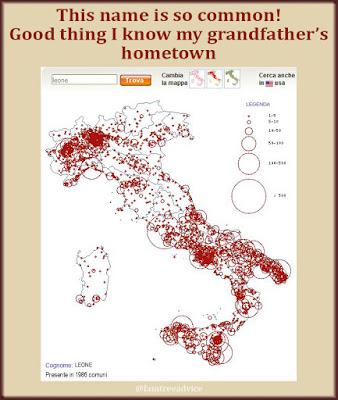All my direct ancestors had Italian last names. I'm lucky to know in exactly which small towns they were born. And the hometown is the key to everything.
 |
| My name of Iamarino is found in only 10 towns. |
Some of my Italian last names (or cognomi, in Italian) are rare. They're specific in origin to a small geographical area. The name Iamarino barely existed outside of my ancestral hometown of Colle Sannita.
But some of my Italian last names are about as rare as Smith or Brown in America. According to an Italian surname search site I like to use, you can find my family names of Leone and Caruso EVERYWHERE.
It would be impossible to identify my Leone or Caruso lines without knowing where my great grandparents were born.
There may not be a word strong enough to emphasize how important it is to know your ancestor's hometown. Critical. Crucial. Imperative. Nope—it's more important than that.
If your foreign ancestors emigrated to the U.S., Canada, Australia, the U.K., etc., cross your fingers and hope they arrived at a good time. Early ship manifests didn't capture much information about the passengers.
 |
| My name of Leone comes from a couple more places. |
If your ancestor arrived at Ellis Island, which was open to immigrants from 1892 to 1954, you're in luck. If you find your ancestor, you should be able to learn the name of their hometown.
I may tell you I'm from New York City, but that's because I'm pretty sure you've never heard of the exact town where I grew up. But my grandfathers never said they were from Naples. They let us know very strongly that they were not Napolitani.
They were very proud of their small towns of Basélice and Colle Sannita. Both towns are in the middle of nowhere, about a 90-minute drive from Naples.
So before you begin chasing the wrong family, you must nail down that hometown.
Find out how. Read about other ways of finding your ancestor's hometown in Where Did Grandpa Come From?





